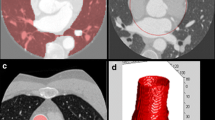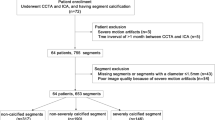Abstract
Purpose
True automated detection of coronary artery stenoses might be useful whenever expert evaluation is not available, or as a “second reader” to enhance diagnostic confidence. We evaluated the accuracy of a PC-based stenosis detection tool alone and combined with expert interpretation.
Methods
One hundred coronary CT angiography datasets were evaluated with the automated software alone, by manual interpretation (axial images, multiplanar reformations and maximum intensity projections in free double-oblique planes), and by expert interpretation aware of the automated findings. Stenoses ≥ 50 % were noted per-vessel and per-patient, and compared with invasive angiography.
Results
Automated post-processing was successful in 90 % of patients (88 % of vessels). When excluding uninterpretable datasets, per-patient sensitivity, specificity, positive predictive value (PPV) and negative predictive value (NPV) were 89 %, 79 %, 74 % and 92 % (per-vessel: 82 %, 85 %, 48 % and 96 %). All 100 datasets were evaluable by expert interpretation. Per-patient sensitivity, specificity, PPV and NPV were 95 %, 95 %, 93 % and 97 % (per-vessel: 89 %,98 %, 88 % and 98 %). Knowing the results of automated interpretation did not improve the performance of expert readers.
Conclusion
Automated off-line post-processing of coronary CT angiography shows adequate sensitivity, but relatively low specificity in coronary stenosis detection. It does not increase accuracy of expert interpretation. Failure of post-processing in 10 % of all patients necessitates additional manual image work-up.
Key Points
• Coronary CT angiography is increasingly used for detection of coronary artery stenosis
• Computer assisted diagnosis might facilitate and speed up interpretation
• Performance in properly segmented cases compared favourably with manual image interpretation
• However, automated segmentation failed in about 10 % of cases
• Manual reading is still mandatory; computer assisted diagnosis can provide a useful second read





Similar content being viewed by others
References
Taylor AJ, Cerqueira M, Hodgson JM et al (2010) ACCF/SCCT/ACR/AHA/ASE/ASNC/NASCI/SCAI/SCMR 2010 Appropriate Use Criteria for Cardiac Computed Tomography. A Report of the American College of Cardiology Foundation Appropriate Use Criteria Task Force, the Society of Cardiovascular Computed Tomography, the American College of Radiology, the American Heart Association, the American Society of Echocardiography, the American Society of Nuclear Cardiology, the North American Society for Cardiovascular Imaging, the Society for Cardiovascular Angiography and Interventions, and the Society for Cardiovascular Magnetic Resonance. Circulation 122:e525–e555
Achenbach S, Barkhausen J, Beer M et al (2012) Consensus recommendations of the German Radiology Society (DRG), the German Cardiac Society (DGK) and the German Society for Pediatric Cardiology (DGPK) on the use of cardiac imaging with computed tomography and magnetic resonance imaging. Rofo 184:345–368, German
Cheng V, Gutstein A, Wolak A et al (2008) Moving beyond binary grading of coronary arterial stenoses on coronary computed tomographic angiography: insights for the imager and referring clinician. JACC Cardiovasc Imaging 1:460–471
Boogers MJ, Schuijf JD, Kitslaar PH et al (2010) Automated quantification of stenosis severity on 64-slice CT: a comparison with quantitative coronary angiography. JACC Cardiovasc Imaging 3:699–709
Busch S, Johnson TR, Nikolaou K et al (2007) Visual and automatic grading of coronary artery stenoses with 64-slice CT angiography in reference to invasive angiography. Eur Radiol 17:1445–1451
Dodd JD, Rieber J, Pomerantsev E et al (2008) Quantification of nonculprit coronary lesions: comparison of cardiac 64-MDCT and invasive coronary angiography. AJR Am J Roentgenol 191:432–438
Reimann AJ, Tsiflikas I, Brodoefel H et al (2009) Efficacy of computer aided analysis in detection of significant coronary artery stenosis in cardiac using dual source computed tomography. Int J Cardiovasc Imaging 25:195–203
Kang DK, Im NJ, Park SM, Lim HS (2011) CT comparison of visual and computerised quantification of coronary stenosis according to plaque composition. Eur Radiol 21:712–721
Khan MF, Wesarg S, Gurung J et al (2006) Facilitating coronary artery evaluation in MDCT using a 3D automatic vessel segmentation tool. Eur Radiol 16:1789–1795
Arnoldi E, Gebregziabher M, Schoepf UJ et al (2010) Automated computer-aided stenosis detection at coronary CT angiography: initial experience. Eur Radiol 20:1160–1167
Halpern EJ, Halpern DJ (2011) Diagnosis of coronary stenosis with CT angiography comparison of automated computer diagnosis with expert readings. Acad Radiol 18:324–333
Acknowledgments
Tobias Pflederer and Stephan Achenbach have received speaker honoraria from Siemens Healthcare. Stephan Achenbach has received research grants from Bayer Schering Pharma.
This study was supported by the German Government, Bundesministerium für Bildung und Forschung (01EX1012B, “Spitzencluster Medical Valley”)
Author information
Authors and Affiliations
Corresponding author
Rights and permissions
About this article
Cite this article
Anders, K., Achenbach, S., Petit, I. et al. Accuracy of automated software-guided detection of significant coronary artery stenosis by CT angiography: comparison with invasive catheterisation. Eur Radiol 23, 1218–1225 (2013). https://doi.org/10.1007/s00330-012-2717-6
Received:
Revised:
Accepted:
Published:
Issue Date:
DOI: https://doi.org/10.1007/s00330-012-2717-6




